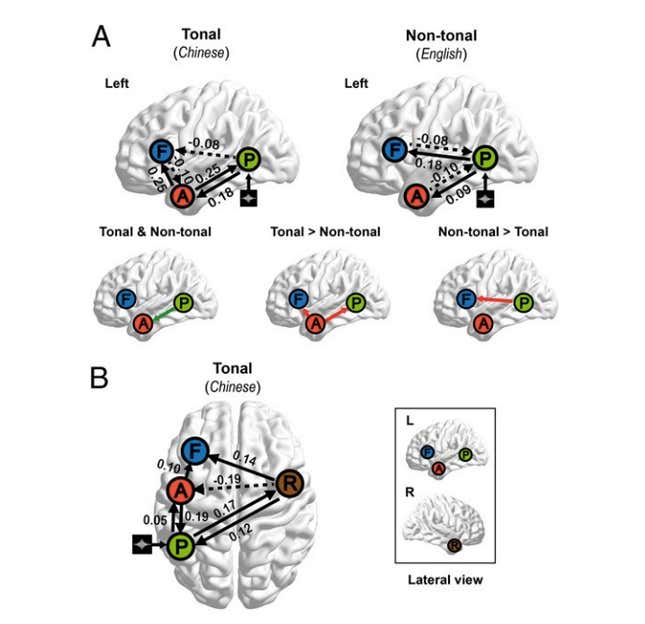If you speak Mandarin, your brain works differently. That’s according to a recent study published in the Proceedings for the National Academy of Sciences. The report is the first to conclude that those who speak tonal languages like Mandarin exhibit a very different flow of information during speech comprehension, using both hemispheres of the brain rather than just the left, which has long been seen as the primary neurological region for processing language.
After analyzing brain imaging data from Mandarin and English speakers listening their respective languages, researchers from Peking University and other universities found that native Mandarin speakers and native English speakers both showed evidence of activity in the brain’s left hemisphere. But Mandarin speakers also saw activation in the right hemisphere, specifically in a region important for processing music, via pitch and tone, that has long been seen as largely unrelated to language comprehension.
Since at least the 1950s, researchers in the field of neurolinguistics have been questioning how languages influence perception, and physiological behavior. This latest study supports one emerging theory, connectionism, that maintains that some languages require interactions across the entire brain. The findings are important for better protecting language-related regions during brain surgery as well as understanding the “constitution of knowledge of language, as well as how it is acquired,” according to the study.
“Pitch processing is crucial for music, but also crucial for tone processing of a tone language. Based on our current results, it is reasonable to hypothesize that all tone languages use both hemispheres,” Gang Peng, deputy director of the Joint Research Centre for Language and Human Complexity at the Chinese University of Hong Kong and one of the study’s co-authors, told Quartz. Other tonal languages include Vietnamese, Cantonese, and Thai.
Specifically, Chinese and English speakers both show activity in three regions in the left hemisphere: the inferior frontal gyrus, the anterior superior temporal gyrus, and the posterior middle gyrus, labeled F, A, and P, respectively (picture A in the image below). But Chinese speakers exhibit activity in an extra area in addition to those three: the superior temporal gyrus (figure R, picture B).

So what differences does it make? For one, according to Gang, there’s likely to be a higher prevalence of absolute, or perfect pitch among native tonal language speakers learning music, a theory that has been floated before.
And for those who are learning Mandarin—including Mark Zuckerberg and Prince William—they may notice that their brains are working just a little bit harder to crack the code of a notoriously difficult-to-learn language.
